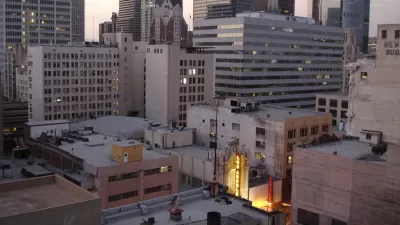With office vacancies climbing and a stubborn supply crunch driving up the cost of housing, some downtowns have emerged at the forefront of a new wave of adaptive reuse.

Writing for CoStar News, Jack Witthaus documents the increasing number of office-to-residential conversions—known in planning parlance as adaptive reuse—underway around the United States.
Office-to-residential conversions are occurring nationally as demand for office space fades. One Wall Street, the former home of Irving Trust bank, recently wrapped its five-year, $1.5 billion transformation into a condo building in lower Manhattan. It is now the biggest office-to-residential conversion in the city’s history. In Salt Lake City, Houston-based developer Hines plans to convert the 217,000-square-foot, 24-story South Temple Tower in downtown Salt Lake City into a 255-unit luxury apartment complex. Projects are also in the works in Dallas and Atlanta and in Tacoma, Washington, among other cities.
Witthaus helpfully notes a few states where legislators have passed laws to assist the trend. In California, for example, where the market demand for adaptive reuse is particularly strong, the state’s latest budget included “calls for spending $400 million as an incentive to developers to convert commercial and office buildings into affordable housing in the budget years 2022-23 and 2023-24.” In New York, “Gov. Kathy Hochul signed a bill into law in June to simplify the process to convert some hotels within or near residential zoning districts to operate as permanent residential spaces. These hotel conversions may be eligible for some funding through state grants.”
The article documents many of the challenges facing office-to-residential conversions to help readers make sense of the scale of the potential to address the nation’s housing shortage through adaptive reuse. Challenges include location—office buildings aren’t always located near amenities that would serve residents—and construction issues like making windows operable for residences.
Witthaus also notes that the new office stock in California and the Sun Belt is better suited for adaptive reuse.
The article includes a lot more detail and analysis, including specific numbers on office vacancies in California’s troubled downtown office markets.
FULL STORY: From Los Angeles to New York, Underused Office Buildings Become Apartments Amid Housing Shortage

Maui's Vacation Rental Debate Turns Ugly
Verbal attacks, misinformation campaigns and fistfights plague a high-stakes debate to convert thousands of vacation rentals into long-term housing.

Planetizen Federal Action Tracker
A weekly monitor of how Trump’s orders and actions are impacting planners and planning in America.

In Urban Planning, AI Prompting Could be the New Design Thinking
Creativity has long been key to great urban design. What if we see AI as our new creative partner?

King County Supportive Housing Program Offers Hope for Unhoused Residents
The county is taking a ‘Housing First’ approach that prioritizes getting people into housing, then offering wraparound supportive services.

Researchers Use AI to Get Clearer Picture of US Housing
Analysts are using artificial intelligence to supercharge their research by allowing them to comb through data faster. Though these AI tools can be error prone, they save time and housing researchers are optimistic about the future.

Making Shared Micromobility More Inclusive
Cities and shared mobility system operators can do more to include people with disabilities in planning and operations, per a new report.
Urban Design for Planners 1: Software Tools
This six-course series explores essential urban design concepts using open source software and equips planners with the tools they need to participate fully in the urban design process.
Planning for Universal Design
Learn the tools for implementing Universal Design in planning regulations.
planning NEXT
Appalachian Highlands Housing Partners
Mpact (founded as Rail~Volution)
City of Camden Redevelopment Agency
City of Astoria
City of Portland
City of Laramie





























